














By Joshua Ostroff


A decade after The Jazz Singer snu ed out the silent-film era in 1927, jazz cigarettes would make their film debut in Reefer Madness, sparking the age of stoner cinema.
Now if you’ve ever seen this anti-pot propaganda pic at some hazy midnight screening, you’ll know it’s high-camp absurdity. Originally called Tell Your Children, this church-funded cautionary tale earnestly tried warning kids away from “the burning weed with its roots in hell.”
The film shows jazz-soundtracked apartment parties where teens turn into sex-crazed killers with a mere pu of pot. An enterprising exploitationmovie producer bought and renamed it Reefer Madness, added more salaciousness and started screening it in grindhouses to avoid censorship. But he didn’t copyright it.
So when Keith Stroup, founder of the National Organization for Reform of Marijuana Laws (NORML), stumbled across an old print in the
Library of Congress archives in 1972, he bought a copy for $297 and started screening it on college campuses. Soon “reefer madness” was flipped to mean society’s overreaction and NORML had raised $100,000.
more of a plot point. Same with Fritz the Cat, from 1972.


New Line Cinema founder Robert Shaye, then operating the future Lord of the Rings movie studio out of his basement, saw one of those screenings. With the now-ironic movie in the public domain, he began bringing it to midnight screenings across the county, bankrolling his burgeoning studio and proving an audience existed for cannabis-infused films.
While grass played a role in the 1969 classic Easy Rider—when Peter Fonda’s biker and Dennis Hopper’s hippie convince Jack Nicholson’s lawyer to take a pu , they infamously inhaled the real deal—it was
But bud became the whole point in 1978 with Cheech and Chong’s Up in Smoke, the film debut of Cheech Marin and Albertaborn soul musician Tommy Chong who met in Vancouver. While critically reviled, it was beloved by a young audience tired of being criminalized and ready to start laughing back. It also turned its $2 million budget into a $104 million box o ice. Last year, it was even added to the U.S. National Film Registry— 1987’s Dirty Dancing and 2007’s No Country for Old Men—for being “culturally, historically, or aesthetically significant.”
Up in Smoke also codified the subgenre as a lighthearted love letter to an innocuous illegal substance that can help make us feel good and inspired a host of iconic stoner comedies.

The former is still personified by Sean Penn’s Je Spicolli, the stoned surfer from 1982’s Fast Times at Ridgemount High who ordered pizza to class and lived by the philosophy of life that, “All I need are some tasty waves, a cool buzz, and I’m fine.”
A decade later, another student stoner stole another hangout film as Rory Cochrane’s Slater became a breakout highlight of Dazed and Confused, despite appearing alongside Matthew McConaughey and Ben A leck.
While marketed with taglines like “the film everyone will be toking about,” Richard Linklater unsuccessfully pushed back on the studio sales pitch for his film. Linklater said he “didn’t want weed to be the joke. I wanted it to be a natural part of their lives.”
But many others did want weed to be the big joke, probably for the same reason there aren’t a lot of crack-cocaine comedies. Friday was a romp from rapper-turned-
filmmaker Ice Cube, who wrote this 1995 bud-based buddy comedy.
By lowering the stakes of movies like Boyz in the Hood or New Jack City down to a couple dummies with a $200 debt after getting high on their own supply, Cube left a legacy of actually funny sequels, that timeless “Bye Felicia!” meme and the hip-hop stoner sub-subgenre.
How High, for instance, introduced mainstream pop culture to Method Man and his non-Wu BFF, Redman in 2001 with a supremely silly storyline about a supernatural spli
The basic tenets of the stoner comedy had become so set that one of the best jokes of 2000’s Dude, Where’s my Car? (funnier than you vaguely remember) is that it never has to show these dudes smoking up.
A few years later, Asian stoners saw some representation in Harold & Kumar Go to White Castle, which introduced KoreanAmerican actor John Cho,




who went on to play Sulu in the Star Trek, and Indian-American actor, Kal Penn, who went on to work in the Obama White House. (Seriously, he even took a leave of absence to film A Very Harold & Kumar 3D Christmas.) It also re-introduced Doogie Howser child star Neil Patrick Harris, further proving that a stoner comedy on your resume was good business.
An infusion of highquality cool came in 2008 with Seth Rogen’s Pineapple Express. It got great reviews, more than quadrupled its $26 million budget, turned M.I.A’s “Paper Planes” into a hit, and had Rogen boasting that even people who hated it had to admit they loved the cinematography.
This was a far cry from 1998’s Half-Baked. When Dave Chappelle later received the Kennedy Center Mark Twain Prize, his co-writer Neal Brennan recalled the origin story of their 1998 cult classic. “Dave calls me and goes, ‘Hey, if Universal reaches out
to you, tell them we’re writing a weed movie together.’ I was like, ‘What weed movie?’ Dave said, ‘Don’t worry about it.’ Looking back, it made sense that the origins of a weed movie sound like you’d imagine.”
The subtext of stoner cinema was that its antiestablishment attitude could be mined for laughs because smoking pot was safe, even if it was against the law. The danger came from societal oppression, not the plant itself.
But while stoner cinema has largely been extinguished, the comedy-cannabis connection keeps burning, like Doug Benson’s podcast, Getting Doug with High, Minerva Cannabis Dispensary hosting comedy nights in Toronto (a city also boasting a Cannabis Comedy Club and Cannabis Comedy Festival) and standups like Winny Clarke incorporating weed into her sets. More proof that weed really is now just a healthy, natural part of our lives.

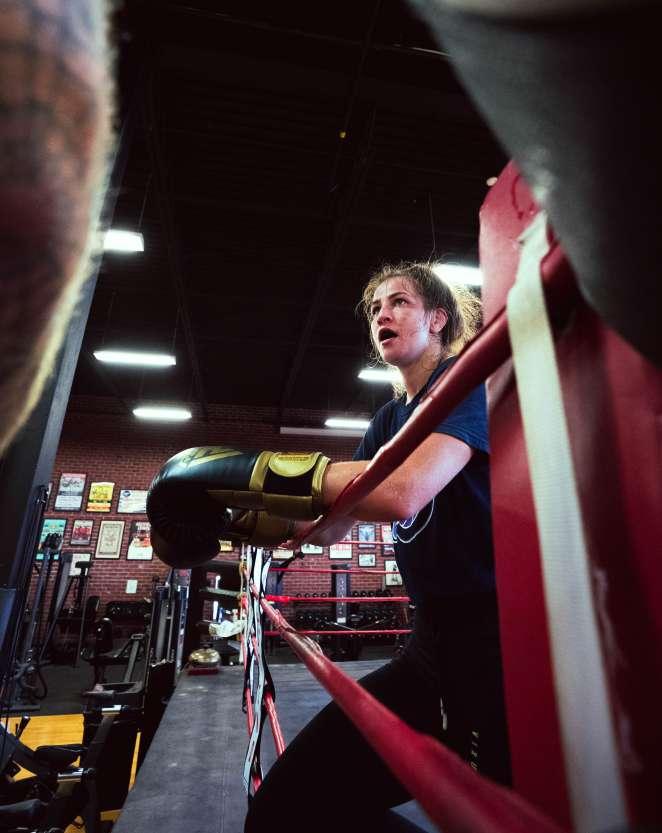

Jasmine Jasudavicius aims to be the greatest Canadian UFC fighter since Georges StPierre. Groundbreaking, determined and ready for the moment, the cannabisfriendly fighter is changing the game
Jasmine Jasudavicius is able to display such ferocity in the ring that her decorum outside the octagon is striking. While fighting, something Jasudavicius has done more of than any other woman in UFC history, the married 34-year-old and the OG team leader of the gym she trains out of in St. Catherines, the 125-pound flyweight shows no hesitation going in for the kill. Against Christina Ricker, an opponent Jasudavicius ko’d in fifty-two seconds, her devastating head kick was followed up with repeated knees to her opponent’s earlobes and ribs. It was, to be clear, a flourish, and such a raw demonstration of power and instinct that this reporter found himself nervous to approach the new Canadian face of the UFC.






she’s learned how to pace herself for when the fight lasts longer than fifty-two seconds, but she’s also desperate and hungry and says she hasn’t worked so hard for so long just to see her moment slip away.
“I’ve never seen anyone work as hard as she does, her whole life is just this. It’s all she cares about, all she does,” says says Goizman, the CEO of Dear Combat, where Jasudavicius trains alongside Mike Malott, a welterweight grappler from Burlington with a black belt who’s also on the Vancouver October 18 fight card. “We have the best team in Canada. No one in this country has come even close to a title since Georges St-Pierre.”
Titles, for Jasudavicius, are obviously important, as is money, acclaim and civic pride in representing her country on the world’s largest mixed martial arts stage. However, equally important, or perhaps moreso, is her advocacy work around young women and their mental and physical health. She stresses
that martial arts are beneficial for everyone but essential, in her estimation, for women. The lessons it taught her, she adds, are life-changing.
“You have to fight through pain and discomfort, fight yourself and your urges, not give up and training teaches you about perseverance, dedication and important values that translate into your regular life,” she says, adding that it’s important not to let anyone “steal your energy.” She says, “I love martial arts for women and young girls because it helps them develop inner-confidence and teaches them that we can take care of ourselves and it gives us confidence and power.”
Grabbing my microphone and addressing the invisible KIND audience, she speaks directly to our readers: “Any girl in this world try martial arts, please.”
Jasudavicius was a firefighter before she became a
professional fighter and she says the number one thing she’s learned about life is that happiness is found in challenging yourself everyday to be better. Whether it’s in sports, like Jasudavicius, or how you show up in work or in your relationships, all of us have room for improvement and learning. Don’t go through the motions, Jasudavicius advises, and uses a gym analogy for how to succeed in life: be the first one in and the last one out, and be humble enough to change.
“It’s real right now. We’re not just faking it anymore,” she says. “The UFC is blowing up and Canada is right back at the top like we were always supposed to be. It’s our moment and we’ll be damned if we’re going to fucking stop now.”
Jasudavicius will have fought Manon Fiorot by the time our issue has gone to press. For updates from the fight and words from Jasmine Jasudavicius, please see kindmagazine.ca.


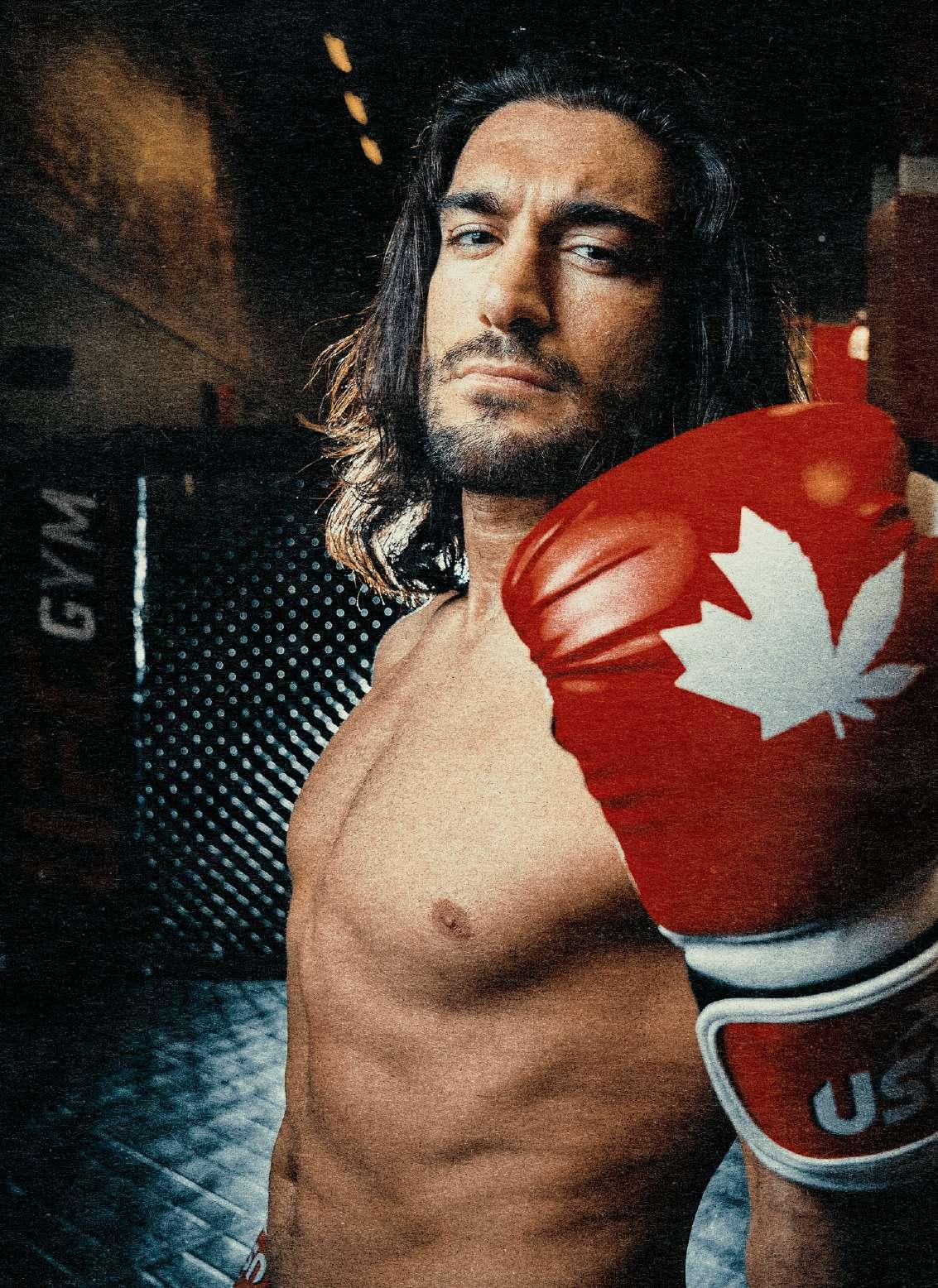
The Ultimate Fighting Championship has always been onboard with weed. Dana White, who resurrected the UFC from a failed business to the juggernaut we see today—the UFC does more than US$1-billion in revenue annually and has broadcasting deals in more than 200 countries—took CBD o its banned substances list before the NBA, NFL or professional soccer. In the summer of 2019, White launched an eight-year partnership with Edmonton’s Aurora Cannabis to research CBD at the UFC Performance Institute in Las Vegas. White, talking to his fighters, could see the writing on the wall.
“When you think about this, the amount of money that’s going to go into the testing and the research of this deal is going

to a ect our athletes,” said White at the press conference, alongside Aurora CEO Terry Booth, when announcing the deal. “Eventually, the research is going to help regular people like us that workout every day or deal with chronic pain. I believe that this thing really is the future and when we see things like this we’ve always been first to dive in.”
Diving into cannabis has a storied history in the UFC, and it’s not just cover star Jasmine Jasudavicius, who was pu ing on a joint with her sparring partner when we pulled into her gym. Elias Theodorou was the first professional athlete in North America to receive a therapeutic use exemption for cannabis. Elias, a friend with long dark hair, piercing brown eyes, an easy laugh and a killer sidekick, passed away from colon cancer in 2022, but his legacy lives on. (Jasmine cites Elias as a hero). He was our first health columnist at KIND, and spoke eloquently about his work as an advocate for the plant.
“The way cannabis has worked for me I think is going to open the eyes of many other athletes,” Theodorou told KIND. “I feel the tides are going in the right direction and I’m just getting warmed up, getting focussed. The future looks good for cannabis in sports.”
Cannabis in sports is now commonplace, and it’s not just CBD. Last year, the New York Times did a survey amongst active NHL players and thirtyeight per cent said they used edibles during the season. Of course, the list of athletes who use weed—from Kevin Durant to Mike Tyson, Alan Iverson to Riley Cote, Ricky Williams, pictured and the entire American team at the CBD
company Mendi, including Sue Bird and Megan Rapinoe—could fill a Hall of Fame roster. It’s the sports professionals, admired and revered, obviously in peak condition and granted a soapbox, who’ve done more than nearly any consumer group with cannabis advocacy. Ms. Jasudavicius told KIND that the plant works for her and her peers and helps her deal with pain, stress and di iculties sleeping when coming home after a hard night at the gym. Cannabis provides pain relief and helps her relax.
“For athletes competing in a sport, I think cannabis is beneficial because it helps you shut down and helps when your body hurts,” Jasudavicius says. “When you’re training and your body hurts and you’re over eighteen, I think cannabis is better for you than Advil, Tylenol, opioids or whiskey. It really works for me.”
Cannabis stocks rallied last month with US President Donald Trump talking about how cannabis can provide pain relief in senior citizens. CBD, said Mr. Trump, could “revolutionize senior health care.” Athletes, more in tune with their bodies than perhaps anyone else, have long known what the President now espouses about the benefits of weed. Blazing a proud trail in cannabis advocacy are the fighters with the UFC and professional boxers—athletes whose living is earned through recovery, and their tolerance of pain.
Cannabis plays a role in the health & wellness routines of many readers of KIND. Some of the best athletes in the world use—and have always used—weed.
By Ben Kaplan











!"#$% &'()*% +% ,-'./"01%

The Nigerian artist behind the new graphic novel Fela: Music is the Weapon on how art, music and Fela Kuti helped one Torontonian own his story
STORY
BY BEN KAPLAN
ARTWORK BY JIBOLA FAGBAMIYE
The Nigerian artist behind the new graphic novel Fela: Music is the Weapon on how art, music and Fela Kuti helped one Torontonian own his story.
Fela Kuti is amongst the most influential musicians of alltime. The Nigerian revolutionary who blended funk, soul and indigenous African sounds in the 1960s and 70s lived a life as wild as the music he recorded. With more than 200 arrests in his native country, and 27 ex-wives, Kuti is a one-of-a-kind talent whose larger-than-life lifestyle not only changed music, but was the source material of the hit play Fela, the Musical, which had a sold-out eighteen month run on Broadway. Jibola Fagbamiye, a Nigerian raised in Toronto and supremely talented graphic artist, always knew that Kuti was a musician he should be proud of. But it wasn’t until he mixed African history with his love of comic books and pop culture that he was able to bring his bold project to light. His new book is fresh and dynamic and tells a biopic story with a creative lens.

“You can’t just tell the cradle-to-the-grave story. With Fela, you have to introduce the magical elements and introduce the world to our culture,” says Fagbamiye, 44, adding that much of popular hip hop and electronic music today owes its roots to the early records of Fela Kuti. “I wanted to use pastels, panels and colours and employ all my favourite aesthetics to tell the story of an artist who never could be tied down. The artwork had to look the same way.”
The book exists as a colourful history lesson and a wild demonstration of 21st century art, with influences from SpiderMan to Roy Lichtenstein to Basquiat on display. In telling Kuti’s story, which includes the night in 1977 when the Nigerian military sent 1,000 soldiers to burn down the musician’s home, Fagbamiye goes from black and white to vivid colour to magic realism in establishing the world in which Kuti lived. The musician, who avoided alcohol, was a cannabis devotee and, like Lee ‘Scratch’ Perry in Jamaica, employed an otherworldly dimension to his art.
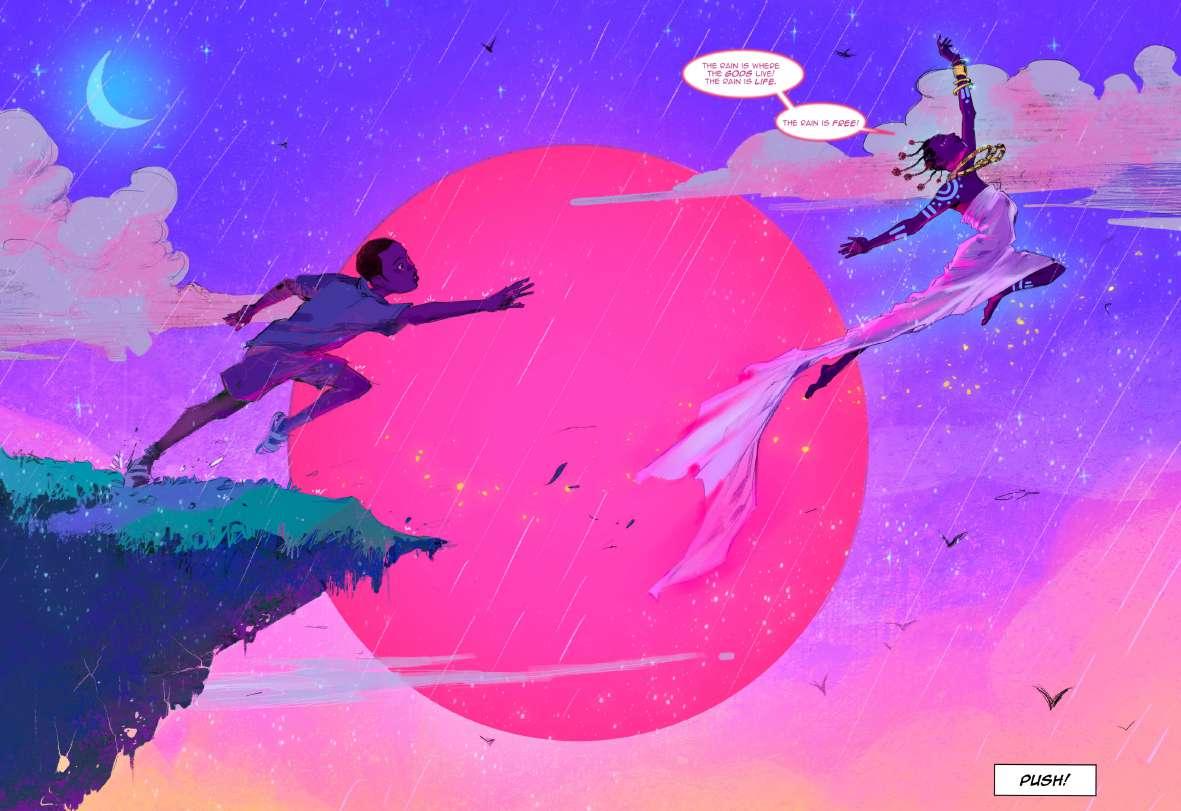
“If you look at the art direction of our story, it’s almost like the arc of Fela’s songs—they take you on a journey and we wanted the reader to experience that same sensation with this book,” Fagbamiye says, matching his art to the rhythms of an improvisational 30-minute Fela Kuti jam. “We were thinking about the book like a movie—in creating anything, it’s about how the reader is going to experience it. With this book, we wanted to get the reader to join us on a ride.”
Fela Kuti’s rise was singular, chaotic and disruptive especially so to Nigerians, says Jibola Fagbamiye, whose parents forbade the budding young artist to listen to the subversive tunes. Jibola says that it was a friend in high school who finally turned him on to Kuti’s music (at the time, he mostly listened to Bob Marley). Once



Available via the OCS and wherever fine cannabis products are sold.
"I have to be sure that every
joint functions perfectly and is
made
with the best possible materials. It is my artwork every step of the way from seed to smoke.”


Mikey Roots, master grower, photographed by KIND outside his greenhouse in Leamington, Ontario.

that happened, he says, he began to feel civic Nigerian pride. Living in Toronto, felt like the perfect time to create the book.
“Back home, I’d get my ass kicked if I was listening to Fela,” he says with a laugh, but mentions the artist was so much more than his ex-wives and drugs. “Fela had this line, ‘99.99% of what you hear about Africa is wrong,’ and that’s the story we’re trying to tell—the story of a rebel—but also the story of a country, my people and the whole range of the African experience: how we laugh, how we love, how we cry.”

The book is a triumphant artistic statement and a reclamation of one of African music’s most misunderstood influencers, still a dominant influence on the most popular music today.
For Fagbamiye, Fela: Music is the Weapon is a labour of love.
“My book is a love letter to Nigerians and Africans and to nonAfricans, it’s a chance to learn,” he says. “I wanted to celebrate everything. I use my art to make sense of the world.”




The newest revelation in house music is a hip hop head from the Galloway Projects
STORY BY BEN KAPLAN PHOTOGRAPHS BY GENELLE CRUZ

At the downtown headquarters of Universal Records in Toronto, Tyrique Clark is explaining his ascent from a wild 11-year-old in East Scarborough to the in-demand house music star Tyriqueordie, promoting his new ep. With fits, starts and revelations—a journey which took him from Lil Wayne to Azealia Banks, with a huge OVO assist—the stylish 29-year-old with a lisp and ride-or-die motivation, says music was all he ever wanted to do.
“I was writing stories and 8-bar verses as a kid and always saw things di erent,” he says, on the eve of releasing You’re Not Invited, a sentimental house lament that’s showcasing a new side of the rave scene veteran who threw his ep release party at a strip club. “I come from Galloway, that’s a government housing
complex and it’s very trench over there, very gritty, but I viewed it from the opposite lens—I found a lot of light.”
The light Tyriqueordie shines is appealing, and growing every day. He spends time in the studio, he says, like Kobe Bryant practicing jumpers and knows that he’s found something that works. Originally, his neighbourhood looked down on house and electronic music and he was encouraged to stay in his more traditional hip hop lane, which he calls boombap. But as he ventured into the creative community of the underground rave scene during COVID, he says his world opened up and he saw a new place for his music to live.
“Being Black, for me, it felt like entering the rave scene would be a lot harder because
where I come from if you listen to rave music people don’t want to hang out with you,” he says, adding that in 2020 he began performing live at underground clubs in secret locations, like underneath the Gardiner Expressway or else out by the train tracks in the woods.
“When I started getting into the scene, people welcomed us with open arms and I started making great connections and realized there was something missing that only I could bring.”
Tyriqueordie had already been making music for more than a decade when he touched upon the style which now dominates his music and his live shows. Influenced by underground hip hop like MF Doom, but with the crossover dreams of Travis Scott, the musician now says he wants to do for rave


music what Beyoncé has done with country: take it back to its roots.
“House music started o Black and unfortunately Black people started to kick it to the side and I’d love to bring that energy back,” he says. “We got my brother Shaboozey doing his thing on the country charts, Tyriqueordie will do that for house music.”
The new single is almost an anti-love song and follows the long tradition of artists who wish they could settle down with the woman they love but just can’t because of their lifestyle, even though it’s breaking their heart. Tyrique says the first few times he listened to it completed—a track he envisioned from opening beat to chaotic conclusion—he cried.
“That song is pretty much a pen to a girl I love but I know I can’t because of who I am,” he says, adding that he’s a Gemini. “I can love, but I can also not love because I’m scared and the song is saying that I’m sorry we broke up, but we had to because I’m a fucked up guy and if I bring you along, it’s only going to bring you down.”
Meeting the young musician who says he enters the flow state onstage and can completely dissociate from life itself when he performs, feels like a full circle moment for him and KIND. Tyriqueordie worked at an underground dispensary before legalization and, once pot became legal, sold Health Canada-stamped prerolls and ounces at Sessions, where he used to read our magazine,
including the cover story on Wiz Khalifa, from whose TaylorGangorDie meme inspired his name. He shakes his head at the irony of his journey.
“Sessions was my last job actually, and it was a great job,” he says, with a laugh. “It pretty much started the whole thing o and it will be a beautiful thing to go back there and see myself in the magazine. It’s just the last perfect image of how far I’ve come.”
You’re Not Invited came out on October 17. For more on Tyriqueordie, including live dates, see @tyriqueordie.

Scratching the surface with DEEJAY T-JR., Canada’s most award-winning DJ
DEEJAY T-JR. has won the prestigious DMC Canadian Championship three times. One of the greatest turntable artists in the world—and oftentimes the only female representative—T brings a soulful, influential mix to every record she chops. She teaches KIND editor Ben Kaplan about what it means to be hard.
KIND: How did you first get into DJing and what do you love about music?
DEEJAY T-JR.: Hip hop, the culture and every element of hip hop—MCing, DJing, breakdancing, and gra iti.
KIND: What did you love?
T: Music is everything. It’s an experience. It’s universal. It’s inspiration—and it’s brought me across the globe.
KIND: What are five records you think everyone should hear—your all-time five favourite discs?
T: O The Wall / Thriller, Michael Jackson (or any MJ record); Live At The Harlem Square Club, Sam Cooke; The Marshall Mathers LP, Eminem; Get Rich Or Die Tryin’, 50 Cent Exodus, Bob Marley; Nevermind, Nirvana
KIND: Being a woman in a male dominated field like DJing, how do you stay true to yourself?
T: Most people don’t want to understand what that means. I define my own morals and values. I don’t let the world decide who I am. If people gravitate towards my work, that’s great. If not, that’s cool too. It’s healthy not to appeal to everyone. Why would you want that?
KIND: What was your goal when you first began?
T: Become great—and have fun. I didn’t know it was possible to do this for a living. Everything that’s come since then has been a blessing.
KIND: Had you planned on becoming a 3X DMC Canadian Champion at the World DJ Championships?
T: I always wanted to compete. My focus was on how I was going to get there. My first major battle was Red Bull 3Style in 2018, where I placed 3rd overall. This was the first time I hit the podium. At this point, I’d been on the national and international stage within a two-year span. I just needed to work harder. A lot harder. And I did. I trained tirelessly until my work was undeniable.
KIND: What’s it like to be considered the Top 10 DJs in the world and often regarded as the best in Canada?
T: What I can say is this: hard work, works
KIND: What do people most get wrong about you?
T: A common misconception people have about any high-level performer is thinking and assuming we became successful overnight. There’s no such thing.
KIND: Explain.
T: We do what we do because we love to do what we do. No amount of money, accolades, likes, followers, or material gain will ever be a substitute for that. None of that matters; that’s not what drives us. I can tell who has heart and who doesn’t from a mile away. It’s easy to spot. It shows up in your work, work ethic, attention to detail, precision, care, finesse, and how unbearable “mistakes” feel to you—the perfectionist.
KIND: How does that show up in the mix?
T: Elite performers put in the work that nobody sees—and that silent grind will always be our advantage.
KIND: You told me once that Kobe and Eminem are people you channel when competing. How do you balance that side of your work with your personal life?
T: I don’t believe in balance. That’s not what got me here. When I hear the word “balance” I hear the word “complacent.” This level of intensity is my baseline. It never really goes away, but over time you learn how to channel it intelligently, depending on the situation.
KIND: As a DJ who regularly performs at hip hop shows and competitions, I think it’s cool that you don’t smoke weed. What’s your relationship like with the plant?
T: For me, music is my outlet and my freedom. I never felt the need or pressure to smoke or drink. I never allowed industry circumstances to influence my decisions around this.
KIND: Have you ever been tempted?
T: I treat my brain like a muscle—the more I train it, the stronger it gets.
KIND: Clips of you cutting regularly get more than 500,000 views and 4,000 shares and hundreds of comments. What do you do next with the love?
T: Above being a DJ, I am a creator. The greatest achievement and biggest reward is sharing my gift. Seeing turntablism reach that many eyes and ears is incredibly beautiful. It’s important to keep turntablism alive and thriving, so I use that feedback as motivation to keep creating, innovating, and pushing the culture forward. Every clip, every comment, and every share reminds me that there’s a community out there who cares about this art—and that inspires me to keep going.
KIND: Where can our readers find you this fall and what are your plans for the future?
T: This fall, you can find me in Tokyo, Japan, hosting the 2025 DMC World DJ Championships alongside DJ Babu and Craze. Soon after, I’ll be taking the stage in Malaysia for a special showcase in Kuala Lumpur. You can also catch me DJing live each and every Tuesday on twitch.tv/ deejaytjr for T-TIME, where I stream from 1–4 PM EST. As always, my focus remains on elevating my craft and inspiring the next generation of DJs.
For more on DEEJAY T-JR., follow her at @deejaytjr on Instagram, youtube.com/ deejaytjr and tiktok.com/@deejaytjr.




































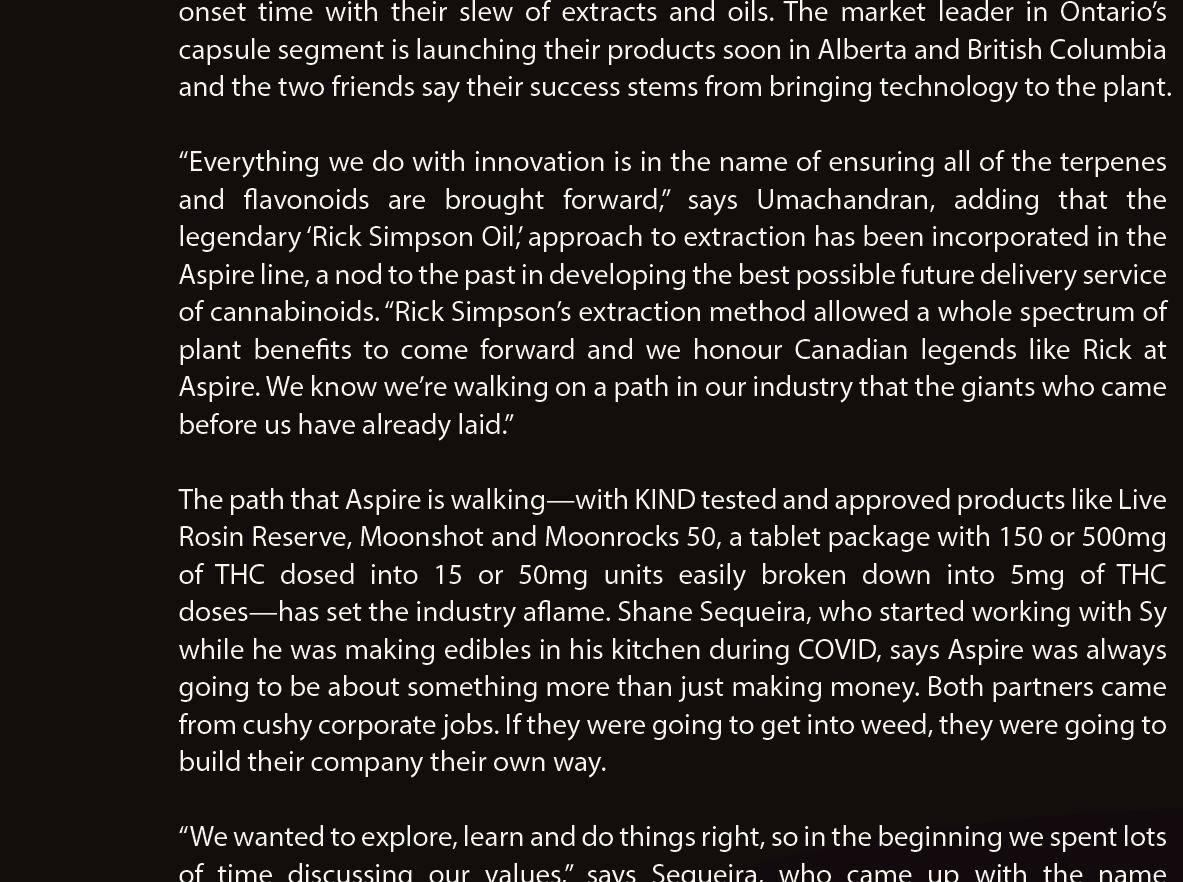













CANADA’S PREEMINENT FITNESS INSTRUCTOR KARINA VEE HAS SOME THOUGHTS ON HOW TO LEAN INTO



















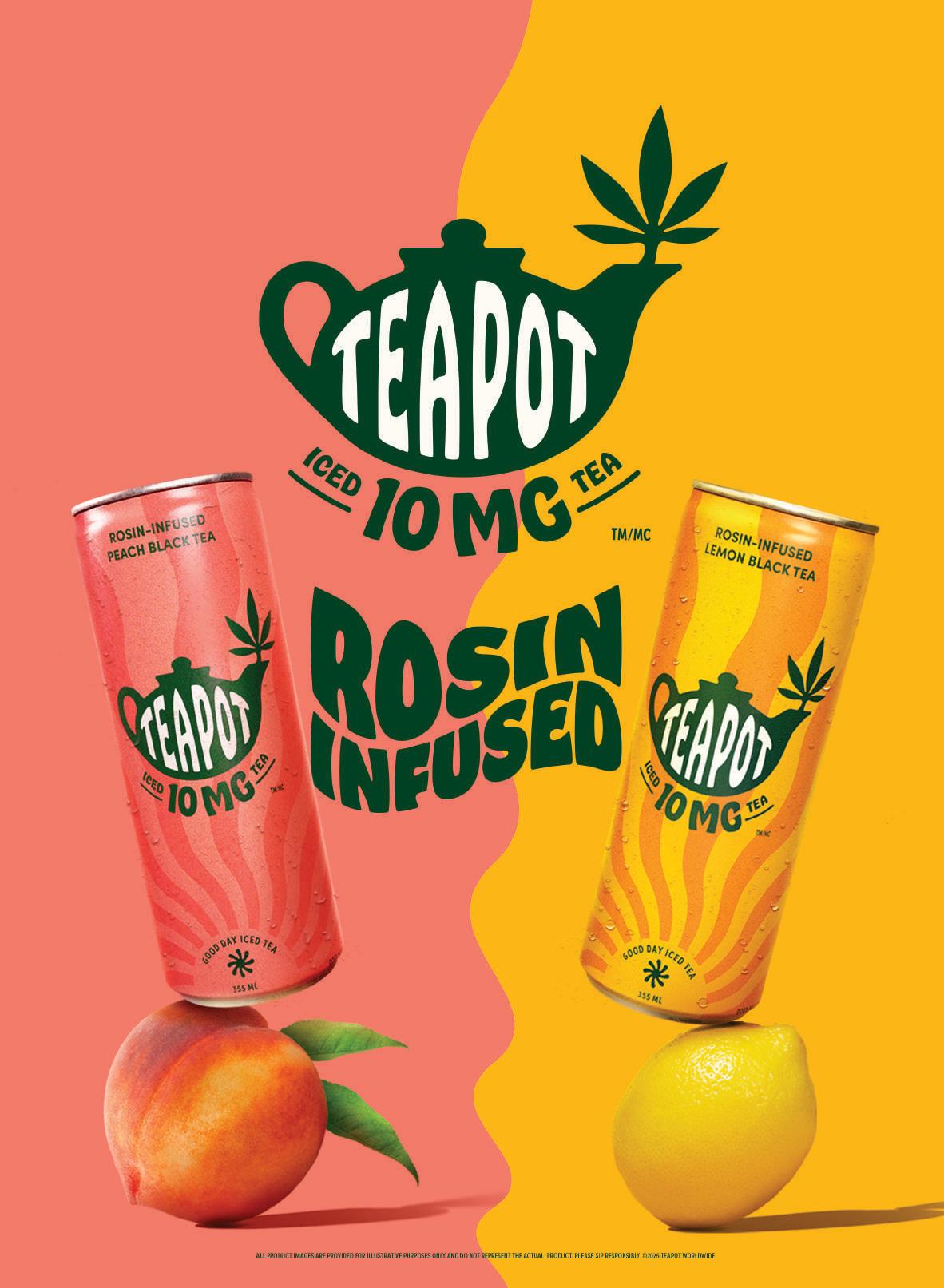













































By Ben Kaplan


Called by philosopher Mark Kingwell a “perverse, bleak and often hilarious Romeo-andJuliet tale,” Smith’s electric, provocative prose has a way of making sense (and poking fun at) the way we all misbehave. Self Care, Smith’s tenth book, concerns the unlikely love/hate a air between a liberal and an incel and the results, not surprisingly, told in a propulsive, addictive fashion, lends a comment not only on modern love, expensive housing, immigration and left and rightwing rage, but a subtly beautiful meditation on alienation, and the value of connection—to keep our worst instincts at bay. KIND editor Ben Kaplan caught up with Smith after drinking too much at his book launch in Toronto.
RUSSELL SMITH IS INARGUABLY ONE OF CANADA’S GREATEST WRITERS. SELF CARE, HIS LATEST, ADDRESSES ALIENATION, INCELS AND OODLES AND OODLES OF GOOD AND BAD SEX.
Ben Kaplan: It’s so incredible how vividly you create the somewhat scary worlds of both Daryn and Gloria in your new novel. What made you want to bring these people to life?
Russell Smith: I’ve been interested in the lives of young people generally, and through the creative writing courses I taught over the years I met many young women experiencing problems that I never had to go through.
BK: Like what?
RS: Precarious employment, working for content farms or turning out communications for some corporation while being paid peanuts and really having no job or relationship security.
BK: Ug. Sounds pretty bleak yet, there’s always such sophistication and glamor in the young. Why focus on this demographic?
RS: I’ve always been interested in young people. They have more sex and go out and party more and there’s more drama in their lives to write about.
BK: Why are people—just like our audience working in pot stores—having di iculties with relationships?
RS: I think with everyone on dating apps, it makes it hard to commit, and maybe especially for young men, because they have too many options. And even those who are welleducated and sensitive and say all the right feminist things— “hipsters,” for lack of a better word—still aren’t necessarily good boyfriends because they won’t commit.
BK: Incels, this weird male movement of guys unable to attract women and thus hate them, sometimes violently, seem particularly self-hating and fraught.
RS: Certainly, and yet two di erent women confessed to me of having this romantic fantasy about taking one of these guys by the hand and showing him what a true relationship looked like. It’s a rescue fantasy. You know that even though they are misogynists these guys claim that they believe in taking care of women, being a provider and being monogamous, and there is something appealing to that.
BK: Maybe we’re in a current cultural moment that’s literally driving people insane.
RS: Income inequality and lack of housing and job security are certainly making life precarious, and everyone’s dealing with it in di erent ways; Gloria, through her left-wing ideologies, Daryn with his anti-immigration marches. They are both lonely and they also both think the society is unjust—they just have di erent solutions to the injustice.
BK: They also both have their hang-ups around sex.
RS: Statistics actually show that young people are having less sex now than they did twenty years ago and I’m not sure what to make of that; perhaps it’s because of their online life, working from home and just not going out as much. I don’t know. Both my characters are very nervous around sex for their own reasons. Gloria doesn’t want to make herself vulnerable. Daryn is just massively shy.
BK: The book makes plenty of interesting points on our self-help culture, labels and this weird fetish around having some kind of failing. Can you unpack your thoughts on the moment we’re in?
RS: I think there’s something new in the culture which is boasting about disadvantage, especially mental or psychological disadvantage, being very proud of one’s limitations and identifying primarily as one’s neurosis.
BK: Gabor Maté said everyone’s su ering from trauma!
RS: The word trauma has definitely had its meaning hugely expanded recently. It has come to mean any kind of bad experience. Which means that yes, everybody can now say they have had trauma. Which would mean we all have PTSD. This is part of the really unscientific self-help and mental health advice we’re bombarded with online.
BK: What do you mean?
RS: Everyday self-proclaimed experts give online advice and nine-tenths of it is complete nonsense. All these health scares and trends around mental illness, like ‘take this online quiz and see if you have autism or ADHD!’ And of course you know your result will come back positive, and that seems to make everybody so happy.
BK: It’s the same with being ‘neuro-divergent,’ which, of course, it’s no disrespect to any of these mental health issues, which are of course serious, but perhaps being overly diagnosed.
RS: The skyrocketing in popularity of this word just over the last five years—along with the rise in ADHD diagnoses!— is really startling, particularly in artistic milieux. Part of the reason for this is that we must apply for grants to make a living and the grant applications are more about your identity than your work. So for white people in particular “neurodivergence” is a way to claim some form of marginalization. And it’s not provable or falsifiable—anyone who has experienced anxiety or depression can claim it, and that means all of us. And here’s a parallel with the incels: they also glorify victimhood.
BK: It’s great to be talking about books in KIND. I feel like we’ve featured more astronauts than authors.
RS: My son is sixteen and both of his parents are professional writers and he will not read books. The second we got him a smartphone, books were done. Maybe it’s a bit of rebellion, but I’m afraid to say it’s also just that people don’t read books much any more because video is easier.
BK: Make the case Russell Smith and close our Health & Wellness issue. Why should people read books for pleasure and, OK, fine—for their mental health?
RS: Maybe the whole industry should be culled. We publish too many books that no one reads.
BK: Russell. . ..
RS: Maybe we should go underground again. Samizdat publishing.
BK: C’mon—
RS: Okay. I see writing fiction as primarily an experiment with the e ects of language. Fiction is an exciting art form because it requires active participation. You don’t sit back and absorb a book like you do a video or movie, you read words and translate them into images, so you’re actively constructing the fictional world for yourself.
BK: Why do that when we can just watch porn?
RS: Well, there is quite a bit of sex in my books! But fiction illustrates the big picture— politics, economics, war, migration—and mixes the emotional and the personal at the same time. A novel can be about a relationship and a war at the same time, in the very same scene. I don’t think any other artform does that nearly as well.
BK: Yes!
RS: The other thing that’s exciting about fiction is it lets you read about other perspectives, a 19th century cavalry o icer or an African chief or an aristocrat in London—we’re not these people, but we discover their lives aren’t that di erent from ours.
BK: And what’s the value of that?
RS: It provides a glimmer of recognition of an
emotion or situation that maybe you’ve been through and had trouble articulating. There is an incredible satisfaction in reading a nuanced and accurate description of a complicated feeling that you were only vaguely aware of—or that you thought you were the only one to experience.
Self Care is out now on Biblioasis. To join the KIND book club and begin with Russell’s new novel, please find details at kindmagazine.ca.


we did it. Kush (cks) Cookies is now available in a 510 cart. NO FLUFF. NO FILLER. Just full-spectrum chaos in a cart. Kush Cookies FSE is pure resin— nothing added, nothing watered down. Just 100% single strain input with zero added terps. Built for ripping anywhere at anytime this rig was built to put your mind into the clouds and lay the body down somewhere soft. We love what we do and our commitment to the plant and the high is unwaivering. We will continue to make products that meet your needs and hopefully blow away any expections. Thank you for choosing us. We love trees & we love you.

A higher standard for creative thinkers, since 2013.